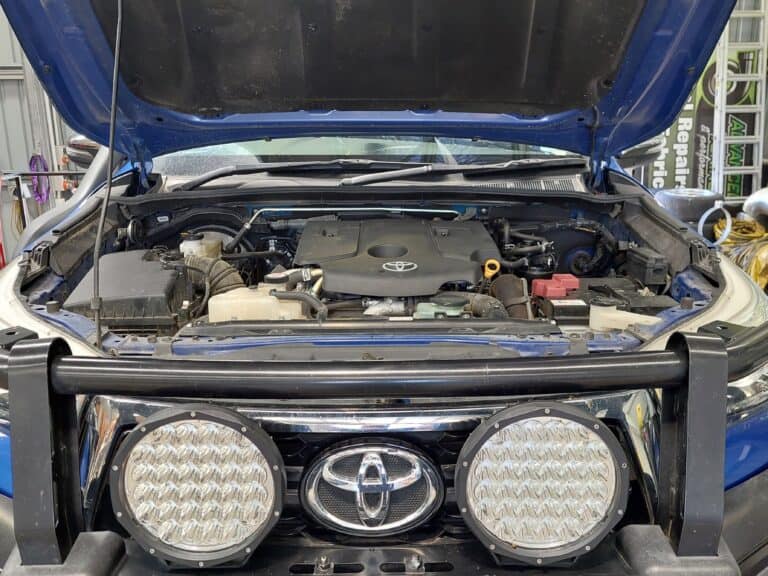The Toyota Hilux and Fortuner equipped with the 2.8L 1GD-FTV diesel engine have earned a reputation for reliability, torque, and off-road ability. But even these rugged machines benefit from regular software updates—also known as ECU (Engine Control Unit) calibration updates.
If you own a MY18–19 Hilux or Fortuner, there’s a good chance there are newer calibration versions available for your vehicle. In this article, we’ll explain why Toyota releases these updates, what they typically address, and why it’s worth checking if your vehicle is up to date.
What Are ECU Software Updates?
Your vehicle’s ECU controls critical engine functions like fueling, boost pressure, emissions controls, and throttle response. Manufacturers release updated calibration IDs (CIDs) over time to address issues or improve performance.
These updates can include:
- Improved emission control strategies
- Better fuel economy under specific conditions
- Smoother drivability and throttle response
- Fixes for known engine management issues
- Compliance with stricter emissions testing
What is a “Burn Up” Calibration ID?
In Toyota’s internal systems, “Burn Up” refers to the latest recommended calibration ID for a given engine/variant. Dealerships and specialists use these lists to determine which vehicles are eligible for updates.
For example, older calibration IDs on the Hilux or Fortuner may have minor limitations or be more prone to triggering emissions-related fault codes. The “Burn Up” version is designed to be more robust and reliable.
Example of Calibration ID Changes
Below is a sample of how Toyota tracks these updates. Each row shows a previous calibration ID (your vehicle might have this now), and the corresponding Burn Up (latest) ID Toyota recommends:
| Previous CID | Burn Up CID |
| 3FA87100 | 3FAM0100 |
| 3FA87200 | 3FAM0100 |
| 3FAM0100 | 3FAM3100 |
Why Should You Update?
Many owners don’t realize their diesel ECU has updates available. These are not just for emissions compliance—they can also improve how the engine behaves in real-world driving. Benefits can include:
- Reduced DPF regeneration frequency
- Fewer fault codes and warnings
- Smoother acceleration
- Potential for better fuel economy
- Compliance with regional emissions testing
How Do You Get the Update?
Toyota dealerships can check your ECU calibration and flash the latest software. Independent workshops with the right equipment (for example, Techstream) can also apply these updates.
If you’re tuning your Hilux or Fortuner, it’s especially important to start from the latest factory calibration. This ensures your tuned file is built on the most stable and improved Toyota release.
Final Thoughts
Toyota’s 2.8 1GD-FTV engine is built to last, but software evolves to keep up with emissions requirements, address issues discovered in the field, and improve customer satisfaction.
If you own a MY18–19 Hilux or Fortuner, consider checking your current ECU calibration ID against the latest “Burn Up” list. Staying up to date is a simple way to keep your truck running its best.
| IMV – Hilux/Fortuner | ||
|---|---|---|
| Pervious CID | HC Limit CID | Burn Up CID |
| 3FA87000 | 3FAM0000 | 3FAM0100 |
| 3FA87100 | ||
| 3FA87200 | ||
| 3FA80000 | 3FAM3000 | 3FAM3100 |
| 3FA80100 | ||
| 3FA80200 | ||
| 3FA83000 | 3FAM4000 | 3FAM4100 |
| 3FA83100 | ||
| 3FA83200 | ||
| 3FA81000 | 3FAM5000 | 3FAM5100 |
| 3FA81100 | ||
| 3FA81200 | ||
| 3FA82000 | 3FAM6000 | 3FAM6100 |
| 3FA82100 | ||
| 3FA82200 | ||
| 3F0R7000 | 3FAL1000 | 3FAL1100 |
| 3F0R7100 | ||
| 3F0R7200 | ||
| 3F0R7300 | ||
| 3F0R7400 | ||
| 3F0S6000 | 3FAL3000 | 3FAL3200 |
| 3F0S6100 | ||
| 3F0S6200 | ||
| 3F0S6300 | ||
| 3F0S6400 | ||
| 3F0S7000 | 3FAL6000 | 3FAL6200 |
| 3F0S7100 | ||
| 3F0S7200 | ||
| 3F0S7300 | ||
| 3F0S7400 | ||
| 3F0S8000 | 3FAL8000 | 3FAL8200 |
| 3F0S8100 | ||
| 3F0S8200 | ||
| 3F0S8300 | ||
| 3F0S8400 | ||
| 3F0S9000 | 3FAL9000 | 3FAL9200 |
| 3F0S9100 | ||
| 3F0S9200 | ||
| 3F0S9300 | ||
| 3F0S9400 | ||
| 3F0T0000 | 3FAL0000 | 3FAL0100 |
| 3F0T0100 | ||
| 3F0T0200 | ||
| 3F0T0300 | ||
| 3F0T0400 | ||
| 3F0T1000 | 3FAM1000 | 3FAM1200 |
| 3F0T1100 | ||
| 3F0T1200 | ||
| 3F0T1300 | ||
| 3F0T1400 | ||
| 3F0T2000 | 3FAM2000 | 3FAM2100 |
| 3F0T2100 | ||
| 3F0T2200 | ||
| 3F0T2300 | ||
| 3F0T2400 | ||
| 89663-FA870 | 89663-FAM00 | 89663-FAM01 |
| 89663-FA871 | ||
| 89663-FA872 | ||
| 89663-FA800 | 89663-FAM30 | 89663-FAM31 |
| 89663-FA801 | ||
| 89663-FA802 | ||
| 89663-FA830 | 89663-FAM40 | 89663-FAM41 |
| 89663-FA831 | ||
| 89663-FA832 | ||
| 89663-FA810 | 89663-FAM50 | 89663-FAM51 |
| 89663-FA811 | ||
| 89663-FA812 | ||
| 89663-FA820 | 89663-FAM60 | 89663-FAM61 |
| 89663-FA821 | ||
| 89663-FA822 | ||
| 89663-F0R70 | 89663-FAL10 | 89663-FAL11 |
| 89663-F0R71 | ||
| 89663-F0R72 | ||
| 89663-F0R73 | ||
| 89663-F0R74 | ||
| 89663-F0S60 | 89663-FAL30 | 89663-FAL32 |
| 89663-F0S61 | ||
| 89663-F0S62 | ||
| 89663-F0S63 | ||
| 89663-F0S64 | ||
| 89663-F0S70 | 89663-FAL60 | 89663-FAL62 |
| 89663-F0S71 | ||
| 89663-F0S72 | ||
| 89663-F0S73 | ||
| 89663-F0S74 | ||
| 89663-F0S80 | 89663-FAL80 | 89663-FAL82 |
| 89663-F0S81 | ||
| 89663-F0S82 | ||
| 89663-F0S83 | ||
| 89663-F0S84 | ||
| 89663-F0S90 | 89663-FAL90 | 89663-FAL92 |
| 89663-F0S91 | ||
| 89663-F0S92 | ||
| 89663-F0S93 | ||
| 89663-F0S94 | ||
| 89663-F0T00 | 89663-FAL00 | 89663-FAL01 |
| 89663-F0T01 | ||
| 89663-F0T02 | ||
| 89663-F0T03 | ||
| 89663-F0T04 | ||
| 89663-F0T10 | 89663-FAM10 | 89663-FAM12 |
| 89663-F0T11 | ||
| 89663-F0T12 | ||
| 89663-F0T13 | ||
| 89663-F0T14 | ||
| 89663-F0T20 | 89663-FAM20 | 89663-FAM21 |
| 89663-F0T21 | ||
| 89663-F0T22 | ||
| 89663-F0T23 | ||
| 89663-F0T24 | ||
| PRADO | ||
|---|---|---|
| Pervious CID | HC Limit CID | Burn Up CID |
| 36A19000 | 36AB8000 | 36AB8100 |
| 36A19100 | ||
| 36A19200 | ||
| 36A19300 | ||
| 36A19400 | ||
| 36A21000 | 36AB9000 | 36AB9100 |
| 36A21100 | ||
| 36A21200 | ||
| 36A21300 | ||
| 36A21400 | ||
| 89663-6A190 | 89663-6AB80 | 89663-6AB81 |
| 89663-6A191 | ||
| 89663-6A192 | ||
| 89663-6A193 | ||
| 89663-6A194 | ||
| 89663-6A210 | 89663-6AB90 | 89663-6AB91 |
| 89663-6A211 | ||
| 89663-6A212 | ||
| 89663-6A213 | ||
| 89663-6A214 | ||



